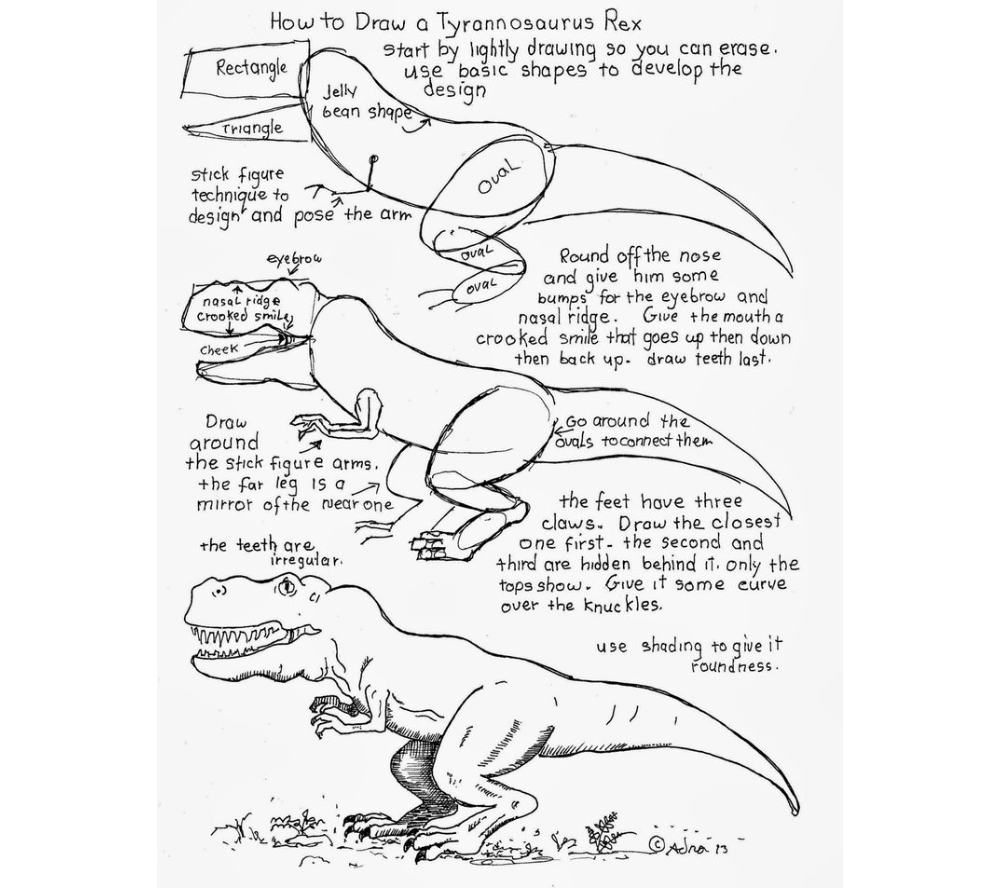How to Draw a Tyrannosaurus Rex (Detailed & Perfected Guide)
Materials Needed: Pencil, eraser, paper, optional fine liner/shading tools.

1. Light Sketching & Basic Shapes
-
Start Lightly: Use a hard pencil (e.g., 2H) to sketch faint lines for easy erasing.
-
Basic Shapes:
-
Head: Draw a tilted oval for the skull.
-
Body: Use a large oval for the chest and a smaller one for the hips.
-
Tail: A long, tapering curve from the hips.
-
Limbs: Simple cylinders for arms and legs.
-
2. Stick Figure Posing
-
Arms: Use the stick figure technique to pose the tiny arms. T. rex arms are short—bend one at the elbow for dynamism.
-
Legs:
-
Near Leg: Draw a thick, bent leg with a raised foot (action pose).
-
Far Leg: Mirror the pose but slightly obscured by the body (perspective tip: lighter lines for distance).
-
3. Head Detailing
-
Nose & Brow:
-
Round the snout and add bumps above the eyes (brow ridges) and along the nasal ridge for texture.
-
-
Mouth:
-
Crooked Smile: Sketch a jagged “W” shape for the upper jaw, peaking at the nostrils, dipping at the mid-jaw, and rising again.
-
Teeth: Irregular, leaf-shaped teeth. Vary sizes—larger near the front, smaller toward the back. Add slight curves to mimic serrations.
-
4. Limbs & Claws
-
Arms: Flesh out the stick arms with minimal muscle definition. Two claws per hand (T. rex had two fingers).
-
Feet:
-
Closest Foot: Draw three curved claws. Start with the largest middle claw, then the side claws partially hidden behind it.
-
Knuckles: Add bumps and curves over the toes for realism.
-
5. Ground & Stance
-
Ground Line: Sketch a faint horizontal line under the feet. Add cracks or rocks to imply weight.
-
Balance: Ensure the center of gravity aligns over the feet (lean the body slightly forward for a charging pose).
6. Shading & Depth
-
Light Source: Decide direction (e.g., top-left). Shade opposite sides (under the jaw, tail, and legs).
-
Techniques:
-
Use hatching for rough skin texture.
-
Darken areas around the eyes, nostrils, and between teeth for contrast.
-
7. Final Touches
-
Refine Lines: Trace over the final sketch with a softer pencil (2B) or pen. Erase guidelines.
-
Optional: Add scales (small, irregular ovals) or scars for personality.
Pro Tip: Study fossil references for accuracy—especially the skull shape and posture (modern T. rex depictions avoid the old “tripod” stance).
